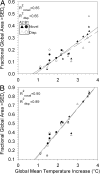Projected distributions of novel and disappearing climates by 2100 AD
- PMID: 17389402
- PMCID: PMC1851561
- DOI: 10.1073/pnas.0606292104
Projected distributions of novel and disappearing climates by 2100 AD
Abstract
Key risks associated with projected climate trends for the 21st century include the prospects of future climate states with no current analog and the disappearance of some extant climates. Because climate is a primary control on species distributions and ecosystem processes, novel 21st-century climates may promote formation of novel species associations and other ecological surprises, whereas the disappearance of some extant climates increases risk of extinction for species with narrow geographic or climatic distributions and disruption of existing communities. Here we analyze multimodel ensembles for the A2 and B1 emission scenarios produced for the fourth assessment report of the Intergovernmental Panel on Climate Change, with the goal of identifying regions projected to experience (i) high magnitudes of local climate change, (ii) development of novel 21st-century climates, and/or (iii) the disappearance of extant climates. Novel climates are projected to develop primarily in the tropics and subtropics, whereas disappearing climates are concentrated in tropical montane regions and the poleward portions of continents. Under the high-end A2 scenario, 12-39% and 10-48% of the Earth's terrestrial surface may respectively experience novel and disappearing climates by 2100 AD. Corresponding projections for the low-end B1 scenario are 4-20% and 4-20%. Dispersal limitations increase the risk that species will experience the loss of extant climates or the occurrence of novel climates. There is a close correspondence between regions with globally disappearing climates and previously identified biodiversity hotspots; for these regions, standard conservation solutions (e.g., assisted migration and networked reserves) may be insufficient to preserve biodiversity.
Conflict of interest statement
The authors declare no conflict of interest.
Figures




References
-
- Crowley TJ. J Climate. 1990;3:1282–1292.
-
- Siegenthaler U, Stocker TF, Monnin E, Lüthi D, Schwander J, Stauffer B, Raynaud D, Barnola J-M, Fischer H, Masson-Delmotte V, Jouzel J. Science. 2005;310:1313–1317. - PubMed
-
- Intergovernmental Panel on Climate Change. Climate Change 2001: The Scientific Basis. IPCC Third Assessment Report. New York: Cambridge Univ Press; 2001.
-
- Easterling DR, Horton B, Jones PD, Peterson TC, Karl TR, Parker DE, Salinger MJ, Razuvayev V, Plummer N, Jamason P, Folland CK. Science. 1997;277:364–367.
-
- Thomas CD, Cameron A, Green RE, Bakkenes M, Beaumont LJ, Collingham YC, Erasmus BFN, Ferreira de Siqueira M, Grainger A, Hannah L, et al. Nature. 2004;427:145–148. - PubMed
Publication types
MeSH terms
LinkOut - more resources
Full Text Sources
Other Literature Sources

